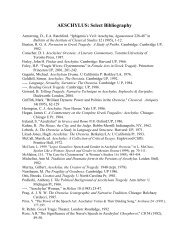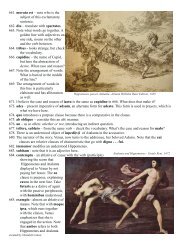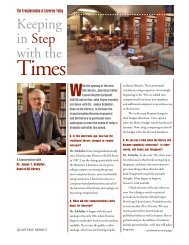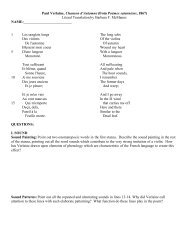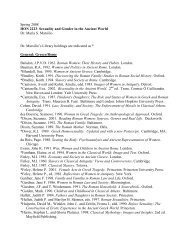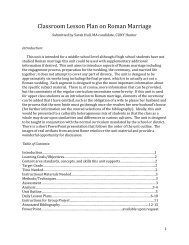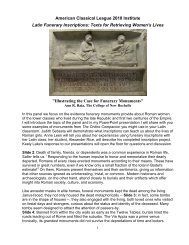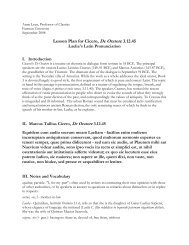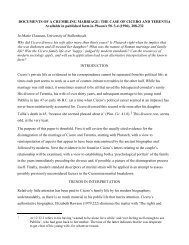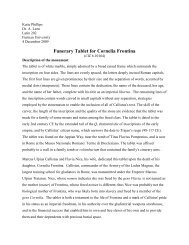Create successful ePaper yourself
Turn your PDF publications into a flip-book with our unique Google optimized e-Paper software.
<strong>LATIN</strong> <strong>METER</strong> II: HORACE<br />
by Michael Hendry<br />
Horace’s odes are mostly written in stanzas of four lines, <strong>and</strong> all but one (4.8) are written in<br />
multiples of four lines, even when the meter repeats every line or every two lines.<br />
1. AEOLIC <strong>METER</strong>S<br />
These are Horace’s favorite meters, borrowed from the Greek poets Sappho <strong>and</strong> Alcaeus, after<br />
whom they are named. They lived on Lesbos in the sixth century B.C. <strong>and</strong> wrote in the Aeolic<br />
dialect of Greek. The indentations will help you to recognize them. The Greater Sapphic is a<br />
rare variation on the Sapphic: the longer line is just a Sapphic line with an extra choriamb.<br />
Alcaic: u – u – –|– uu – u – u<br />
u – u – –|– uu – u – u<br />
u – u – – – u – u<br />
– u u – u u – u – u<br />
Sapphic: – u – – –|uu – u – u<br />
– u – – –|uu – u – u<br />
– u – – –|uu – u – u<br />
– u u – u<br />
Greater Sapphic: – u u – u – u<br />
– u – – –|uu –|– u u – u – u<br />
Horace uses these meters in the following poems:<br />
Alcaic Sapphic GrSp<br />
I 9, 16-17, 26-27, 29, 31, 34-35, 37 2, 10, 12, 20, 22, 25, 30, 32, 38 8<br />
II 1, 3, 5, 7, 9, 11, 13-15, 17, 19-20 2, 4, 6, 8, 10, 16<br />
III 1-6, 17, 21, 23, 26, 29 8, 11, 14, 18, 20, 22, 27<br />
IV 4, 9, 14-15 2, 6, 11<br />
2. ASCLEPIADEAN <strong>METER</strong>S<br />
There are four ‘Asclepiadean’ lines, but the differences are minor. The first three consist of a<br />
spondee at the beginning, an iamb at the end, <strong>and</strong> either one, two or three choriambs in between.<br />
The fourth is the same as the first, but one syllable shorter. (As with Sapphics <strong>and</strong> Alcaics, these<br />
are named after the Greek poets who invented them.)<br />
1
(G) Glyconic: – – –uu– uu<br />
(A 1 ) Lesser Asclepiadean: – – –uu– | –uu– uu<br />
(A 2 ) Greater Asclepiadean: – – –uu– |–uu– | –uu– uu<br />
(P) Pherecratean: – – –uu– u<br />
A whole family of meters is <strong>for</strong>med from these. They are usually numbered ‘First Asclepiadean’<br />
through ‘Fifth Asclepiadean’, but different editors assign different numbers to the different<br />
combinations. The ones Horace uses are these:<br />
Book I II III IV<br />
A 1 A 1 A 1 A 1 1 30 8<br />
A 1 A 1 A 1 G 6, 15, 24, 33 12 10, 16 5, 12<br />
A 1 A 1 PG 5, 14, 21, 23 7, 13 13<br />
GA 1 GA 1 3, 13, 19, 36 9, 15, 19, 24-25, 28 1, 3<br />
A 2 A 2 A 2 A 2 11, 18 10<br />
3. MISCELLANEOUS <strong>METER</strong>S<br />
These are only used in one or two poems each. The first two Archilocheans are similar to elegiac<br />
couplets, in that they combine a dactylic hexameter with a shorter dactylic line of either four<br />
or two <strong>and</strong> a half feet. The third starts out dactylic <strong>and</strong> turns iambic, while the Hipponactean is<br />
entirely iambo-trochaic. The ionic meter is particularly easy — <strong>and</strong> monotonous.<br />
First Archilochean: – u u – u u –|u u – u u – u u – u (1.7, 28)<br />
– u u – u u – u u – u<br />
Second Archilochean: – u u – u u –|u u – u u – u u – u (4.7)<br />
– u u – u u u<br />
Third Archilochean: – uu – uu –|uu – u u|– u – u – u (1.4)<br />
– – u – u|– u – u – u<br />
Hipponactean: – u – u – u u (2.18)<br />
u – u – u|– u – u – u<br />
Ionic: u u – – u u – – (3.10)<br />
u u – – u u – – u u – –<br />
u u – – u u – –<br />
u u – – u u – – u u – u<br />
2



